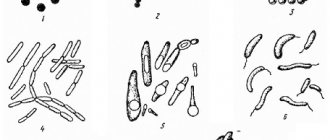Abortion during breastfeeding is not uncommon. Contrary to popular belief that pregnancy cannot occur during breastfeeding, this is confirmed by an isolated case in gynecology. In this case, the woman is rarely ready for a new pregnancy; she has to have an abortion during lactation.
The first ovulation period occurs one and a half months after the birth of the baby. In most cases, this applies to women who are not breastfeeding. There were cases of egg release in the fourth week after birth during lactation. The period of breastfeeding for 6 weeks protects against unwanted pregnancy by only 98%.
Why can pregnancy occur during breastfeeding?
It is possible to become pregnant after childbirth if the woman does not use contraception. Doctors do not recommend giving birth, since the body has not had time to recover. Repeatedly carrying a child will seriously damage your health, especially if a caesarean section was performed. In the latter case, giving birth is allowed no earlier than after 3 years. In case of unplanned pregnancy, doctors insist on abortion to preserve health.
Reason #1
The cause of pregnancy may be the frequency of feeding. When putting a baby to the breast 5-6 times a day, with an amount of milk consumed of 150-180 ml per feeding, the risk of becoming pregnant is higher than for those women whose children eat a smaller volume, even if they are fed more often.
Reason #2
The likelihood of conception increases if the mother follows an hourly feeding schedule. You should not wait 3-4 or more hours between feedings if your baby asks to eat. The optimal interval time is 2 hours.
Reason #3
Rare applications. With the introduction of complementary foods, usually at 4 months, the mother begins to breastfeed less frequently, and by 7-8 months the baby is completely switched to baby food. In such cases, the likelihood of conception increases.
Abortion during lactation
The method of abortion during breastfeeding is selected for the patient depending on factors. Experts take into account:
- timing of pregnancy;
- the mother's desire to continue lactation;
- previous method of childbirth.
The patient can stop feeding for a few days while expressing milk, or continue feeding after a few hours. It all depends on the specific situation, which a woman should discuss with her doctor.
Medication
Abortion with medication is the use of drugs that cause the embryo to be rejected from the uterine cavity. The procedure requires a fee; in order to undergo it, the patient must be no more than two weeks late in her period, and up to five weeks pregnant. Mostly products containing mifepristone are used. There is no information about the effect of the substance on lactation and the baby’s body through feeding.
According to official sources, mifepristone enters the patient's blood in low doses and is quickly eliminated, which is not a reason to stop feeding.
The second most popular substance is misoprostol. It enters milk in minimal portions and is quickly excreted from it.
The third substance is gemeprost. Similar to the previous two, but is eliminated from the body within a day, and not after 5-6 hours. To be completely sure that the drugs will not harm the baby, doctors recommend starting feeding a few days after a medical abortion, usually 3-14 days.
Mini abortion
A vacuum abortion is performed using a machine that sucks out the fertilized egg attached to the uterus. The method is the most gentle for the patient, but is carried out only in the early stages. The procedure lasts no more than 10 minutes. It takes place using local anesthesia. Lidocaine and propofol are used, which enter the milk in small quantities and are removed after a couple of expressions. This type of abortion involves stopping breastfeeding for several hours.
It is extremely rare, but possible, that a woman is prescribed a course of antibiotics. Then the breastfeeding will have to be stopped while taking the medications.
Surgical
Instrumental abortion is performed by widening the cervical canal and scraping the walls of the uterus with a special instrument - curettage. The procedure is carried out until the 12th week of pregnancy. For medical reasons or rape - up to 22 weeks. This type of abortion is mainly used when the deadlines for more gentle methods have been missed. The operation has consequences in the form of perforation of the uterine walls, infertility, etc. Their appearance depends on the timing of pregnancy and the doctor.
Surgery may have a psychological impact that will affect lactation.
Preparing a mother for an abortion during breastfeeding
Before having an abortion, a woman must consult a doctor, undergo examination, tests and an ultrasound. This is necessary to confirm the presence of pregnancy and choose the method of termination. You can also contact a breastfeeding specialist who will give recommendations on maintaining lactation and tell you about the forced break in feeding and its timing. During this period, you should express the required amount of milk and freeze it in special containers so that the child does not lack nutrition.
In addition, a woman needs psychological help before having an abortion: during lactation, the maternal instinct is highly developed, which can negatively affect the emotional state.
In this case, you can go to a psychologist for help and, after talking with him, consciously decide to continue or terminate the pregnancy. Equally important is the support of relatives and partners during this period, their understanding and approval.
Mother's condition after abortion
During abortions, the patient does not feel anything, except for mild discomfort when the cervix opens. After recovering from anesthesia, you may feel pain in the lower abdomen due to uterine contractions. Nausea and dizziness should also not be a cause for concern. To normalize the condition, a woman needs to lie down for at least an hour. The doctor may place a cold compress on the abdomen to help the uterus contract better. If this does not happen, the patient may be given oxytocin.
To check how the procedure went, the woman needs to have an ultrasound. If embryonic remains are detected, a mandatory surgical abortion is performed. After vacuum and surgical abortions, antibiotics may be prescribed. Drugs are prescribed to destroy microorganisms that can enter the wounded surface of the uterus and cause infection.
After vacuum aspiration and surgery, the woman bleeds from the vagina for some time. On average, this period lasts from 5 to 15 days; normal periods after an instrumental abortion can occur in 28-35 days.
After the procedures, the patient may experience dangerous bleeding and other complications. If a woman observes the following signs, she should consult a doctor:
- bleeding from the vagina did not start immediately after the abortion, but a few days later;
- weak or heavy bleeding;
- lack of blood;
- pain in the lower abdomen;
- nausea, dizziness;
- discharge mixed with pus, too red or having a strong odor.
Artificial termination of pregnancy also has psychological consequences on the patient. After an abortion, a woman needs moral support from family and friends.
How to stop milk after an abortion
There are many reasons why women may need to suppress lactation (stop milk production in the mammary glands):
- Personal reasons for not breastfeeding.
- Medical necessity to stop breastfeeding.
- Voluntary resumption of lactation after completion of the breastfeeding period.
- Permanent or prolonged separation from the child.
To stop lactation while breastfeeding, you will need to interrupt the natural reflexes that promote milk production. The easiest way is to limit the removal of milk from the breast. If milk remains in the mammary gland, the body understands that there is still a supply and will reduce the production of new milk. The fuller the breasts are with milk, the faster its production will stop.
You can express milk only if there is extreme discomfort in the chest and to prevent blockage of the milk ducts and the occurrence of mastitis.
FEATURES OF CESSATION OF LACTATION IMMEDIATELY AFTER BIRTH.
Milk production will quickly cease if the breasts are well secured and supported by a bra, and milk is expressed only to prevent significant discomfort and blockage of the milk ducts. Wearing a durable, well-fitting bra is necessary both during the day and at night. This method is more physiological and effective compared to the outdated tight breast wrap. To absorb milk, absorbent pads are placed in the cups of the bra, which are replaced as they become moisturized. If the breasts are too full, the bra is replaced by a supportive breast wrap with a strip of cotton fabric that supports but does not compress the breasts. Tight compression of the breast does not reduce milk production, but causes significant discomfort. For full engorged breast syndrome (the first week after childbirth), pain and swelling can be reduced with the help of cold compresses and wraps. You can also use a cool shower and place chilled white cabbage leaves in your bra. The leaves are pre-washed and dried, and the protruding parts are cut out of them so as not to cause chest discomfort. Leaves need to be changed every 2 hours or when they become limp. Use cabbage leaves until your breasts stop overflowing with milk. For pain, nonspecific anti-inflammatory drugs such as ibuprofen can be used.
FEATURES OF CESSATION OF LACTATION AFTER WEEKS OR MONTHS OF BREASTFEEDING.
If you are forced to stop breastfeeding that has already begun, measures suitable for stopping lactation immediately after birth will not be enough. A nursing mother produces about a liter of milk per day or more. In this case, it will take time to stop milk production. In this case, to prevent the occurrence of inflammatory breast diseases, you will have to gradually reduce the amount of milk expressed in order to reduce the production of hormones that cause its production. This strategy is similar to natural weaning and helps prevent the development of mastitis.
When you first stop breastfeeding, your breasts will become full. Milk will have to be expressed in volumes and on a schedule, as with breastfeeding, only gradually reducing the amount of milk expressed and increasing the pauses between expressions. You can try to do one less pumping every 3-4 days if there is no significant discomfort in the breast. After some time, there will come a point when you can express milk twice a day, and then only once a day, and finally once every few days, and stop expressing completely.
PHARMACOLOGICAL DRUGS FOR TERMINATION OF LACTATION.
There are also medications and natural nutritional supplements that can help stop lactation faster. There is a method of medicinal cessation of lactation using medications, nutritional supplements and herbs. However, drug cessation of lactation has a lot of side effects and contraindications, so its use can only be carried out after a face-to-face consultation with a gynecologist or mammologist.
HOW TO QUICKLY STOP LACTATION?
The speed of cessation of lactation depends on a number of factors:
- The baby's age and the amount of milk produced.
- Stage of pregnancy when it is terminated (lactation is possible after termination of pregnancy after the 18th week).
- The amount of milk expressed, milk flowing out.
- Pressure on the nipples (during work, sports, sex).
- Presence of next pregnancy.
Some mothers take weeks to stop breastfeeding. For others, the process takes only a few days. However, milk stains on your bra can sometimes be noticed several months or even years after you think that lactation has stopped: for each mother, the process of stopping lactation occurs individually.
BE PREPARE FOR LEAKS!
Even after the cessation of lactation or in its last stages, unexpected copious discharge of milk from the breast is possible. This can happen when hugging a partner, when having sex with him, when being sexually aroused, when thinking about a child, when touching the breast. To prevent unexpected milk leaks, wear absorbent pads in your bra. Keep a spare supply of such gaskets with you. Wear dark-colored tops so that milk stains are not as noticeable. Take a spare set of clothes with you, especially for more important occasions.
Express some milk before leaving the house. If you feel milk leaking, cross your arms over your chest to stop the flow.
In all cases, get advice from a breastfeeding specialist on how best to stop lactation in your case.
CALL A BREASTFEEDING SPECIALIST AT HOME.
- A specialist will come to you at a convenient time. You don't have to go to the clinic and wait in line. Consultations can also be held directly in the maternity hospital (if visits are permissible) or in a medical center.
- A familiar home environment makes consultation easier for both mother and child.
- At home, the consultant will be able to devote more time to both the child and the parents.
- The consultant is always a phone call away: day and night (at night you can call the control room or write to the consultant, the consultant will answer as soon as possible), on weekdays and on weekends.
- Support from a specialist is not one-time consultations, but accompaniment: the consultant will visit the mother and baby again, if necessary, after 2-4 weeks to check how feeding is going and the baby’s weight gain.
In addition to calling a breastfeeding specialist to your home, you can call doctors of the main specialties: pediatrician, surgeon, allergist, urologist, pulmonologist, hematologist, dermatologist, ophthalmologist, ENT doctor, orthopedist, gastroenterologist and osteopath. You can also take tests, perform physiotherapy and massage at home. Infant swimming consultants can advise you at home and conduct a master class.
ADDITIONAL SERVICES AT HOME
- Conducting complex pediatric programs.
- Collection of tests.
- Breast swimming.
- Massage.
- Physiotherapeutic procedures.
- Injections and droppers.
- Preparation of medical documents.
- Patronage of nurses.
HOW TO CALL A BREASTFEEDING SPECIALIST AT YOUR HOME
You can make a house call 24 hours a day by calling:
Features of breastfeeding after medical abortion
After honey abortion breastfeeding needs some adjustment. After taking the first pill, the woman should not feed the baby. If you want to maintain lactation in the same volume, the mother needs to express her breasts with the same frequency with which the baby fed.
Approximately on the fifth day, when the ultrasound is ready, you can continue to breastfeed the baby.
Refusal is caused by a change in the taste of milk due to pregnancy or subsequent miscarriage, or insufficient pumping. This happens rarely; in general, the lactation period is completely restored.
Reasons why you have to interrupt breastfeeding
Often in real life, a nursing mother has to stop breastfeeding, no matter how useful and necessary it would be for a newborn baby. Every mother is aware of the benefits it has for the normal and full growth and development of the child, so she tries to prolong it longer.
The main reasons why nursing mothers have to switch their baby to artificial or mixed nutrition are:
- alcohol or drug addiction of the mother that is subject to treatment;
- oncological diseases of a nursing mother, for the treatment of which chemotherapy or radiation is used;
- the presence of herpetic rashes on the nipples;
- taking anti-tuberculosis drugs, for example, isoniazid;
- taking certain groups of antibiotics, for example, levomecithin or metronidazole, which are contraindicated during breastfeeding;
- lactose deficiency in infants;
- purulent mastitis in the acute stage, which requires urgent treatment;
- abnormal development of nipples and mammary glands;
- the birth of a child premature or too weak, which does not allow him to fully suck on his mother’s breast;
- the mother’s need to be absent for a certain period, etc.
Reading...
The harm and benefits of bananas during breastfeeding
Additionally > Various methods for stopping lactation in a mother
Also, the lactation process may be suspended for reasons beyond the control of the nursing mother. Various stressful situations and a bad mood in the mother can have a very detrimental effect on the process of milk production.
How to return GW if you had to suspend it?
Abortion during breastfeeding causes hormonal changes. Because of this, the taste of milk and its quantity often change. Some relactation methods:
- Frequent application. The frequency of latching the baby to the breast is at least once every 3 hours.
- Skin contact. This method involves frequent presence of the baby next to the mother, free access to the breast so that the baby can take it himself if desired.
- Good nutrition, plenty of fluids. To produce milk, a woman needs to eat right. A diet is not required during this period, but it is recommended to limit the consumption of fatty, fried, smoked, spicy and salty foods.
- Massage. Milk production is promoted by a light massage of the chest and interscapular area.
- Night applications. It is at night that the mother’s body produces prolactin, which is responsible for milk production, so night feedings are useful.
If possible, avoid pacifiers. They satisfy the sucking reflex, the baby is less drawn to the breast. You should not stop feeding, even if the child refuses natural nutrition. Until he starts drinking milk, the woman needs to pump so that the milk does not disappear.
Abortion is unpleasant for any woman psychologically and physically. To avoid consequences, it is important to choose reliable methods of contraception and not rely on chance.
Medical abortion while breastfeeding
The first six months after the birth of a child, a woman’s body goes through a difficult stage of recovery after the enormous stress during pregnancy and childbirth. At the same time, there is a myth among women that during breastfeeding a young mother cannot become pregnant. In fact, the lactation method of contraception cannot be called reliable, since in some women the first ovulation occurs as early as 6 weeks after birth.
abortion during pregnancy
» data-medium-file=»https://i2.wp.com/medcentr-diana-spb.ru/wp-content/uploads/2017/12/abort-vo-vremya-beremennosti.jpg?fit=450% 2C300″ data-large-file=”https://i2.wp.com/medcentr-diana-spb.ru/wp-content/uploads/2017/12/abort-vo-vremya-beremennosti.jpg?fit=790 %2C527″ class=”alignnone size-large wp-image-8140″ src=”https://i0.wp.com/medcentr-diana-spb.ru/wp-content/uploads/2017/12/abort-vo -vremya-beremennosti-825×550.jpg?resize=790%2C527″ alt=”abortion during pregnancy” width=”790″ height=”527″ srcset=”//i2.wp.com/medcentr-diana- spb.ru/wp-content/uploads/2017/12/abort-vo-vremya-beremennosti.jpg?resize=825%2C550 825w, https://i2.wp.com/medcentr-diana-spb.ru/wp -content/uploads/2017/12/abort-vo-vremya-beremennosti.jpg?resize=450%2C300 450w, https://i2.wp.com/medcentr-diana-spb.ru/wp-content/uploads/ 2017/12/abort-vo-vremya-beremennosti.jpg?resize=768%2C512 768w, https://i2.wp.com/medcentr-diana-spb.ru/wp-content/uploads/2017/12/abort -vo-vremya-beremennosti.jpg?w=900 900w" sizes="(max-width: 790px) 100vw, 790px" data-recalc-dims="1″ />
Against the background of hormonal changes, the menstrual cycle may not be restored for a long time, which also does not allow a woman to fully control the likelihood of conception. As a result, unwanted pregnancy during breastfeeding is not uncommon.
Making a decision to continue pregnancy immediately after childbirth is not easy. In some cases, a woman is not yet ready for the birth of a second baby, and in others, repeated births during this period are contraindicated for health reasons (for example, after a cesarean section). This raises the question of having an abortion during breastfeeding. Medical abortion is considered the safest and least traumatic method of abortion in modern gynecology, but can it be performed during breastfeeding? Let's figure it out together with the experienced specialists of the Diana Medical Center.











